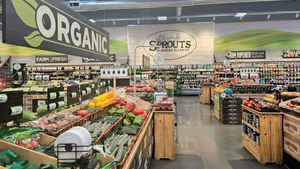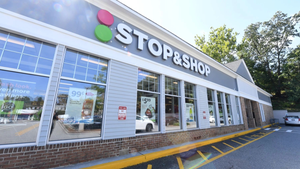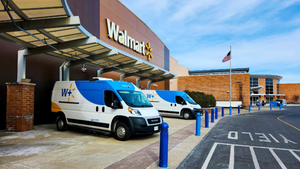FMI: Online grocery sales jumped 300% early in pandemicFMI: Online grocery sales jumped 300% early in pandemic
Food retailers expect e-commerce growth to continue, 2020 Industry Speaks report finds
October 9, 2020

Online grocery sales tripled in the early part of the COVID-19 pandemic as food retailers ramped up an already growing e-commerce business, according to FMI-The Food Industry Association’s Food Retailing Industry Speaks 2020 report.
The annual study, released this week, captured food retailers’ and wholesalers’ initial response to the coronavirus outbreak, as the survey portion of the research — representing more than 37,000 food retail stores — was delayed by several months, until June. “Because of that change, this year’s feedback benefits from retailer insights about the first few months of the pandemic,” FMI said in the report.
On the e-commerce side, food retailers’ saw online sales jump an average of more than 300% in the first several months of the crisis. “The pandemic suddenly and profoundly changed online grocery shopping. Virtually all retailers with online sales saw an increase in these sales during the first months of the pandemic,” the study said.
To meet the demand crush, 83% of retailers surveyed said they added more staff to handle online fulfillment, and 37% earmarked more workers to handle delivery of online orders. FMI noted that, with shelter-in-place and stricter social distancing guidance in effect early in the pandemic, more than half of retailers (51%) urged customers to order online.
In turn, to meet changing shoppers needs and desires, 24% of food retailers reported offering more SKUs online. Some retailers also added new delivery methods, including store pickup (19%) and third-party delivery (16%).
“E-commerce was already advancing for food retailers before the pandemic, and it exploded during the early months of the crisis period,” the 2020 FMI Speaks report said. “Unprecedented developments altered how retailers view e-commerce investments, expectations about future sales growth and challenges from different types of competitors.”

Indeed, in 2019, 75% of brick-and-mortar food retailers cited online retailers selling food as a key competitive concern. Since the pandemic, however, that percentage has shrunk to 62% as stores have boosted their e-commerce capabilities.
“Leading up to the pandemic, competition from online retailers selling food stood out as the biggest competitive challenge facing food retailers,” FMI observed. “This remained the case during the pandemic, even if the level of concern decreased slightly as supermarkets pulled out all the stops just to handle their own surging demand.”
In 2019, online sales represented an average of 2.5% of food retailers’ total sales, up from 1.4% in 2018 and ranging as high as 9% for some companies. Overall, 46% of 2019 sales occurred online.
Forty-five percent food retailers engaged in online commerce saw sales rise more than 20% last year, the study found. Online transactions averaged 5,800 per week, up from 2,150 in 2018, with the average basket size at $104, compared with $38 in stores.

Food retailers reporting online sales offered over 32,000 SKUs online on average in 2019, compared with 28,000 in 2018. Online purchases were brought to customers most commonly via store pickup (77% of retailers) or third-party delivery (86%). Forty-two percent of retailers offered employee delivery of online orders, and 12% enabled pickup at another site.
As on the front end, food retailers used multiple fulfillment options on the back end in 2019. Of those with online sales, 98% fulfilled at least some of their online sales from store shelves. Other methods included fulfillment centers that aren’t automated (9%), in-house warehouses (7%), third-party fulfillment centers (7%) and micro-fulfillment centers (5%).
“In 2019, the food retail industry saw same store sales rise to 3.3%,” FMI President and CEO Leslie Sarasin said in a statement. “Food retailers experimented with new technologies, online sales, and health and well-being initiatives. It turns out, these investments helped pave the way for 2020 so that food retailers were better prepared for challenges the COVID-19 pandemic presented.”
Looking ahead — and influenced by consumer behavior in the early part of the pandemic — 92% of food retailers expect online sales to increase this year, and 73% anticipate an increased shopper basket size, according to the 2020 Speaks report. Similarly, 62% think social distancing practices will have a positive impact on online shopping, and 61% expect online trip frequency to rise.
Food retailers also are getting better prepared on the technology side in anticipation of more omnichannel business. Eighty-three percent said they’re experimenting with e-commerce technology, up from 67% in 2019, and 83% also reported they’re exploring new technologies to improve the customer experience, versus 72% last year. Also, 81% aim to leverage technology to sharpen efficiency, up from 75% in 2019.
“The groundwork laid in 2019 allowed the food retail industry to be nimble this year when grocery stores faced unprecedented demand and the supply chain was dramatically disrupted,” Sarasin added. “In this period, retailers, their associates and their trading partners pursued proactive strategies to feed the nation. The food industry will continue to innovate even when faced with uncertainty.”
Join us on Wednesday, Oct. 14 at 2 p.m. for the Supermarket News webinar "The Online Grocery Boom: Where Do We Go From Here?" with guest speakers Mark Baum from FMI and Nicole Collida at Nielsen. Sign up here.
For our most up-to-date coverage, visit the coronavirus homepage.
About the Author
You May Also Like


.webp?width=300&auto=webp&quality=80&disable=upscale)



